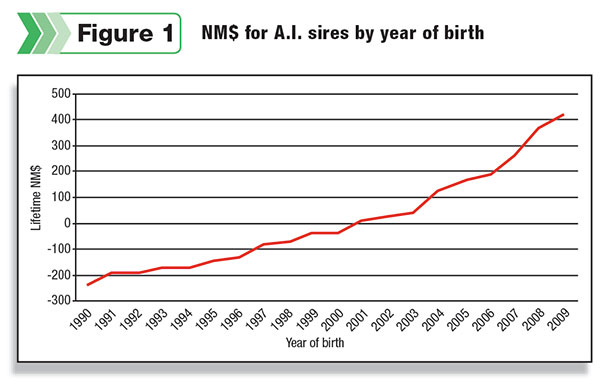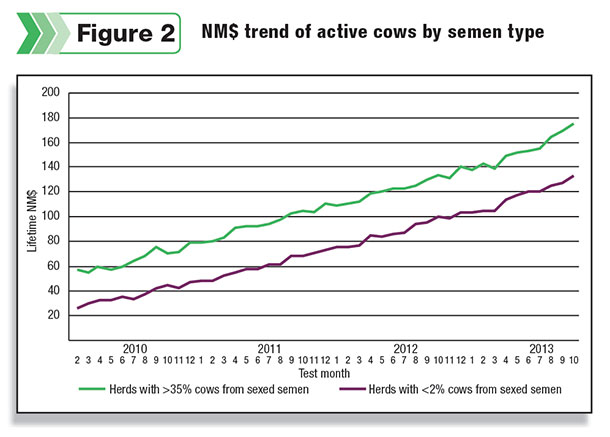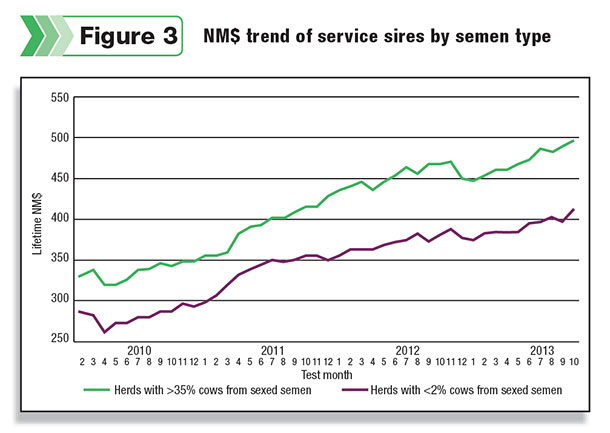Genetics has historically played a minor role in day-to-day herd management when compared to nutrition, udder health and reproduction. Genetic progress for most dairies consisted of selecting A.I. sires that might improve the herd’s main deficiencies, like production, feet and legs or udder composite.
One option was to select higher-reliability bulls that possessed the desired traits. Although the semen would come at a higher cost, performance of resulting offspring would be more consistent. Another cheaper option was to select young sires that, on average, had higher genetic values.
However, due to low reliabilities, there was a lot more variability in the resulting offspring. On the cow side, genetic progress could be sped up through the purchase of higher genetic-merit replacement heifers or embryo transfer.
Culling low genetic-merit cows was not an option because most dairies had insufficient heifer inventories to replace the low genetic-value animals while maintaining herd size.
Modern technology offers a growing list of options when it comes to genetics decision-making. Managing herd genetics is no longer a minor part of the day.
What has changed?
On the sire side, we have seen the rapid adoption of genomic testing. This has enabled A.I. companies to offer young bulls with superior genetics and higher reliability values when compared to traditional young sires.
Another impact of genomic testing is the increased turnover in A.I. bulls and a focus on identifying new genetic traits that will improve overall profitability on the farm. The value of keeping A.I. bulls around for a longer time is diminished because there is a continual supply of new bulls with even better genetics and higher reliability values.

Figure 1 shows the Lifetime Net Merit (NM$) values of A.I. bulls in service by their year of birth. What is most noteworthy is that the improvement of NM$ values from year to year is increasing.
An even bigger change is noticeable on the cow side. With sexed semen readily available, the dynamics of managing a herd inventory and making genetic progress has drastically changed.
A commercial dairy is able to raise enough dairy heifers not only to replace cows that have to leave the dairy due to a health or reproductive problem (involuntary cull) but also replace those cows that are of lower genetic value (voluntary culls) with heifers that have superior genetics.
Another option is to take advantage of higher beef prices and breed the lower genetic-value cows with beef semen. Genomic testing can add higher accuracy to selection of cows or heifers due to the higher reliability of the genetic information obtained on those animals.

Figure 2 shows how some herds using a high percentage of sexed semen have higher Lifetime NM$ values compared to those herds using very little or no sexed semen. Figure 3 shows the Lifetime NM$ values of the service sires being used in the same herds shown in Figure 2.

The combination of the two figures shows how herds using sexed semen are using higher Lifetime NM$ bulls compared to herds with little or no use of sexed semen. Figure 3 also shows how in the last three years, the Lifetime NM$ values for herds using sexed semen are increasing at a faster rate than those not using it.
Increased value of using genetics to improve herd management
When use of improved genetics and higher-reliability A.I. sires is coupled with the selection of the best genetic-value cows and heifers in your herd, the amount of genetic progress that can be made within a herd today dramatically exceeds the amount of progress made just 10 years ago.
DHI data collected shows that cows born in 2011 are on average 351 NM$ higher than cows born in 2001. Cows born in 2001, compared to 1991, are only 225 NM$ higher over that 10-year period. With the tools currently available, expect the rate of improvement to continue to accelerate.
In addition to improvements of production traits such as milk, fat and protein, data on cows and heifers show that PTA Productive Life is rapidly increasing, as is daughter pregnancy rate. Investing in genetics is worth the money. Table 1 shows the quartile breakdowns of current active Holstein cows by various production parameters.

It pays to invest in genetics. Cows in the top NM$ quartile produced 4,500 pounds more milk with higher components and lower SCC scores. With research efforts looking at the influence of genetics on resistance to mastitis, longevity and feed efficiency under way, new traits will be identified. Soon after, we will be able to select A.I. sires based on those traits.
Monitoring genetics
To realize the full value of herd management decisions involving genetics, it is important for producers to monitor genetic progress and manage inbreeding levels to be assured breeding goals are met. Enrolling a herd in a DHI milk-recording program is a great first step.
Herds enrolled in DHI that keep good breeding and animal ID records will obtain genetic information on their cows and heifers. Genetic values can initially be calculated based on parentage.
After the cow freshens, production data will also be included. If the herd participates in genomic testing, DHI data will include the information obtained from genomically tested heifers and cows.
With all this data at your fingertips, what are some of the items you should monitor?
• Genetic progress of the overall herd – This can be done by graphing the average genetic values for active cows and heifers by test day or year of birth.
• Monitor the genetics of your next generation of calves by measuring the genetic progress of service sires used – This can be done by graphing the average genetic values of service sires based on the most recent breeding records of cows and heifers.
• Monitor the effectiveness of the mating program in managing inbreeding levels – This can be accomplished by averaging inbreeding values by year of birth.
• Monitor the consistency of genetics in your herd – This can be accomplished by breaking down the herd in quartiles and comparing the genetics of the four quartiles.
Maintaining good breeding and animal identification records allows producers to analyze various breeding strategies. Evaluating the success of a herd’s breeding strategy can be done by comparing the herd with other herds to determine if the progress being made is similar to or better than that of peer herds.
The future of genetics is bright. To make sure you are maximizing your profitability, use the DHI information available to you to evaluate your breeding decisions. PD
Robert Fourdraine holds a Ph.D. in animal science from Texas A&M.

Robert Fourdraine
Vice President of DHI Operations
AgSource Cooperative Services






